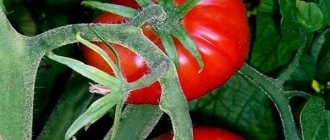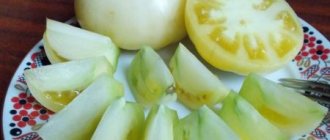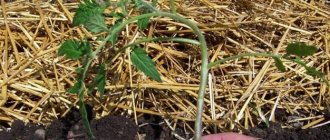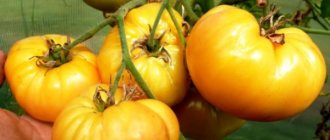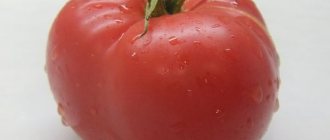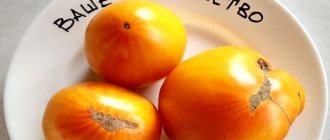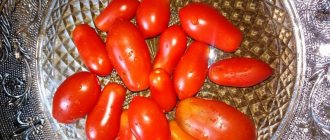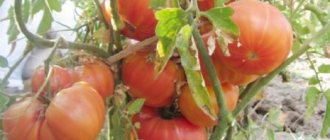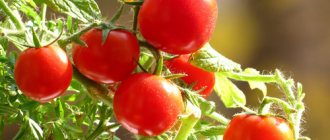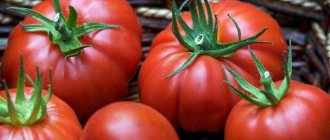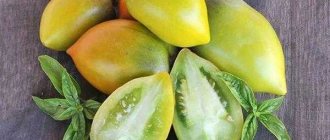The Pablo F1 hybrid was developed in Japan. Its good taste and outstanding commercial qualities will not let any gardener pass by. The seeds are suitable for summer residents of the North Caucasus region.
| Height | Landing location | Ripening time | Fruit color | Fruit size | Origin | Fruit shape |
| Tall | Open ground | Mid-season | Reds | Average | Hybrid | Flat-round |
Description and characteristics of the variety
The cultivar was included in the register in 2008, recommended for the 6th region. It can be grown in private plots in the open air. Salad fruits weighing up to 100 g, red, flat-round. The taste is very good.
The plants are tall, mid-season ripening. Height growth is unlimited. The stems are powerful and leafy. 6 or more tomatoes are tied on the brush.
Description of tomato
A hybrid tomato looks like this:
- Indeterminate bush up to 2 m high in greenhouse conditions, heavily leafy.
- The tomato is endowed with a powerful root system that goes deep into the soil.
- The leaves are large, dark green.
- 5-6 ovaries are formed on the hand.
- The fruits are large in size. Average weight 200 g. Flat-round in shape.
- The skin and pulp of ripe units are red. The skin is dense, which prevents the tomatoes from cracking in rainy weather.
- The surface is smooth. A minority of fruits exhibit weak ribbing.
- The tomato has a sweet and sour taste and is aromatic. Tomatoes of this variety are used fresh, as well as for preparing pickles, juices, and marinades for the winter.
According to ripening time | By type of growth | By type of use | By growing method | Fruit weight (g) | Yield (kg/m²) | Ripe fruit color | Characteristics of the fetus |
| Early ripe | Indeterminant | Universal | For open ground and greenhouses | Up to 200 | Up to 7 | Red | Flat-round, dense, fleshy, sweet in taste |
Advantages and disadvantages
The Pablo F1 hybrid carries the genes of the best cultivators, and therefore has many advantages.
Pros:
- undemanding to care;
- produces even fruits;
- sweet, juicy tomatoes;
- resistant to diseases;
- ties tomatoes in cold and hot weather.
Minuses:
- You cannot collect the seeds yourself. They need to be purchased, and the price of hybrids is not cheap.
The assessment of the taste of the fruit at the tasting was 4.8 points on a five-point scale.
Features of cultivation, planting and care
Sowing seeds for seedlings is carried out 55-60 days before the intended planting in a permanent place. Seedlings dive at the stage of two true leaves. When planting seedlings in the ground for 1 sq. m place up to 3 plants.
Further care for tomatoes consists of timely watering, fertilizing with complex mineral fertilizer, pinching and preventive measures to protect against diseases and pests.
When growing tomatoes in a greenhouse, we recommend installing a drip irrigation system - this will save your time and effort, as well as increase plant productivity and reduce the risk of late blight.
If you grew Pablo tomatoes, please write whether you liked them or not. What was the yield and taste of the fruits like under your climatic conditions? How do you rate the disease resistance of this tomato? Briefly describe the advantages and disadvantages of this tomato in your opinion, and evaluate its taste. If possible, attach to your review a photo of the entire bush or individual fruits you grew. Thank you!
Your reviews of the Pablo tomato and additions to the description will help many gardeners evaluate this hybrid objectively and decide whether it is worth planting or not.
Tomato De Barao striped. Description
Tomato De Barao striped is a real find for farmers and vegetable growers seeking to get the largest harvest. It will also please those who enjoy eating fresh tomatoes not only in summer and late autumn, but also at the beginning of winter.
The variety was born in 1998; since 2000 it has been included in the Rosreestr of Plants. Since then, the popular tomato variety has taken up residence in both farmers' fields and home gardens due to its extraordinary yield and shelf life of the fruit.
Characteristics
The variety is mid-season, the ripening period is 110-130 days. On powerful tall bushes, fruit clusters of 5-10 ovaries are formed. The collection of ripened fruits begins in July and lasts until the first frost.
De Barao striped is a high-yielding variety. From one square meter you can get 5-6 kg of delicious tomatoes with an unusually attractive appearance.
- indeterminate type up to 2 m high;
- the stem is thick, slightly drooping;
- oval fruits weighing 50-70 grams;
- requires support and garters;
- formation of 1-2 stems.
Adapting perfectly to growing conditions, the vegetable crop is not afraid of cold weather and excess moisture. The skin on tomatoes does not burst even during periods of prolonged rain.
Ripe fruits look original and appetizing. As the tomato ripens, the dark green stripes turn yellow-brown. The skin is red and glossy. The pulp is tender, juicy and meaty. In addition to interesting colors, De Barao has a rich taste and aroma. Tomatoes are good both fresh and prepared for the winter. The variety is considered one of the best for pickling, preserving and preparing tomato paste. Thanks to their dense pulp and durable skin, tomatoes can easily be transported and stored for a long time.
Agricultural technology
Seeds for seedlings are planted in early March to a depth of 2-3 cm. By May, the plants are ready for transplanting into open ground or under film cover.
Considering the tallness and spreading nature of the variety, the holes should be placed at a distance of 90 cm, and the planting density should be no more than 2 bushes per square meter. Young plants need feeding; when planting, humus or compost is added to the ground.
The need for watering is at least once a week. After watering, the soil must be loosened.
Tall De Barao tomato bushes need to be tied to a support immediately after planting in the ground. The plant must be pruned regularly, removing side shoots every 4-5 days. It is better to do this in the morning or in sunny weather so that the wounds dry out.
When the fruits on the first lower cluster are completely filled, the leaves under it can be removed, tearing off 2-3 leaves as they ripen.
If the bush has reached a gigantic height, you can limit its growth by cutting off the top.
The variety is resistant to late blight and thrives in different climatic zones, so growing these unpretentious tomatoes is not difficult.
Features of the variety De Barao striped
Powerful De Barao tomato bushes can simultaneously serve as a beautiful green fence for a personal plot. In open ground, they are often planted along wooden fences, which serve as support for stems and a bountiful harvest.
The vegetable crop bears fruit from late summer to late autumn, and in our climatic conditions, not all tomatoes have time to ripen. But they feel great outside the bush. The fruits of this variety can be picked while still green. If the tomatoes are placed in a warm, well-ventilated room, they will ripen. The harvested crop can be stored for up to 2 months without losing its taste and presentation.
The seed material of the De Barao striped variety can be harvested yourself, which also distinguishes this vegetable crop from others.
But preparing seeds is a rather complex and time-consuming process. And we are ready to take it upon ourselves. After all, high-quality seeds are the key to a good harvest!
Features of agricultural technology
The Pablo F1 tomato is cultivated in the same way as other hybrids of this type.
The basic rules are:
- Simultaneously with planting, a trellis is built on the bed or stakes are installed to tie up long stems.
- To get an earlier harvest, the tomato is formed into 1-2 stems. This procedure is carried out strictly according to the rules, otherwise the plant becomes vulnerable to pathogens.
- Leaves at the bottom of the shoots are regularly removed. This way the tomato is better illuminated by the sun and ventilated.
- During prolonged drought, tomatoes become smaller and crack, so watering should be provided.
Attention! Some gardeners leave all the stems on indeterminate varieties. However, this is not advisable. As a result, a lot of green mass is formed to the detriment of the fruits.
Tomato President F1: variety description
| Variety name | The president |
| general description | Early maturing, indeterminate hybrid of tomatoes for growing in greenhouses and open ground. |
| Originator | Russia |
| Ripening period | 80-100 days |
| Form | The fruits are round, slightly flattened |
| Color | Red |
| Average weight of tomatoes | 250-300 grams |
| Application | Universal |
| Productivity of the variety | 7-9 kg per square meter |
| Features of cultivation | There are no special care requirements |
| Disease resistance | It is resistant to many diseases, but requires prevention |
This wonderful hybrid was bred by Russian specialists and was registered as a hybrid variety in 2007. Since then, it has rightfully earned popularity among gardeners and farmers due to its qualities. By type of bush it is an indeterminate, standard plant. Read about determinate varieties here. This bush is quite tall for tomatoes and can reach 100-110 centimeters in height.
Equally well suited for greenhouses, greenhouses and open ground. In terms of ripening time, it is an early ripening species; 80-100 days pass from planting seedlings to the appearance of fruits of varietal maturity; under ideal conditions, the time period can be reduced to 70-95 days.
It is highly resistant to major tomato diseases, which has certainly earned it popularity among both amateur gardeners and farmers. In addition to a number of remarkable properties, this hybrid variety has very good productivity. With proper care and good conditions from the sq. meter you can harvest 7-9 kilograms of excellent fruit.
In the table below you can see what the yield of other tomato varieties is:
| Variety name | Productivity |
| The president | 7-9 kg per square meter |
| Grandma's gift | up to 6 kg per bush |
| Brown sugar | 6-7 kg per square meter |
| Premier | 6-9 kg per square meter |
| Polbig | 3.8-4 kg per bush |
| Black bunch | 6 kg per bush |
| Kostroma | 4.5-5 kg per bush |
| Red bunch | 10 kg per bush |
| Lazy | 15 kg per square meter |
| Doll | 8-9 kg per square meter |
Reviews from summer residents
The hybrid was released relatively recently, so there are few reviews on the forums. Those that do occur are positive.
- Irina from Krasnodar region. I grew tomatoes in the garden. I like to experiment, so I constantly buy something new. I am guided by the photo and description of the manufacturer. I liked the hybrid. The first fruits ripened very early. I harvested it throughout the summer, since fruiting is extended.
- Vdadislav from Belgorod. Last season, I visited a friend at his dacha in the middle of summer, where I tried the tomato in question. I liked the variety. Next season I will buy seeds and also grow a hybrid on my plot.
- Igor from Rostov. Grown commercially. The seedlings were planted in a film greenhouse. Provided care appropriate for indeterminate varieties. The harvest was good and early, which had a beneficial effect on trade.
Tomato Pablo F1 is a hybrid that is gradually gaining its rightful place on the plots of amateurs and professionals. With proper care, a tomato will definitely delight you with a harvest of high-quality fruits in any region of our country.
Growing and caring for the Pablo variety
To grow a tomato or any other crop, you need to put in a lot of effort. Growing a tomato begins with planting seeds in a greenhouse. First you need to prepare the soil in which the seeds will be sown. Let's look at the process of growing tomatoes step by step:
- 7-8 days before planting tomatoes in a greenhouse, fertilize the soil with peat or humus. The soil needs to be dug well and made loose. If the soil is dense, it will be difficult for young roots to grow, which means the plant will slow down its growth.
- Disinfect the soil with a manganese solution or synthetically produced biological preparations (Fitosporin, Trichodermin). The soil must be saturated to at least 30-40 centimeters.
- Seeds must be soaked before planting so that young shoots are stronger and more resilient. For impregnation, you can use a one percent manganese solution or the growth stimulator "Epin".
- Seeds are sown at a distance of 2 centimeters from each other. Such a gap between plants will allow them to develop normally and not shade each other. Before planting, the soil is compacted and watered with warm water. After placing the seeds, the soil must again be watered with warm water.
- For 50-60 days, the seedlings should be in the greenhouse. Optimal climatic conditions combine: +23-25 degree thermal conditions, 60% air humidity. Plants are hardened off ten days before planting in open soil.
- Before placing the sprouts, the wells need to be watered and fertilized with mineral fertilizer. One plant will require a teaspoon of “Nitrophoska” or any other complex fertilizer.
- In the second week after planting the seedlings, install a support. It can be made from an ordinary tree branch (the main condition for a peg is a diameter of at least 4 cm), or an iron rod.
- After the plant takes root, the stage of caring for a tall tomato begins. Care Tips:
- the plant is formed into two stems;
- the stepsons are cut off as the plant grows and is tied up. The shoots should not be allowed to outgrow. Cutting off large shoots harms the normal development of the tomato;
- Water consumption per bush is 5-8 liters in moderate weather. It is recommended to water no more than once every 5 days;
- the soil under the plants can be mulched. Mulch will help maintain soil moisture, protect the root system from being washed out during heavy rains, and reduce the germination of weeds;
- It is imperative to fertilize during tomato flowering so that the plant has the strength to set large fruits;
- the beds must be weeded at least three times during the entire growing season;
- monitor the condition of the plant. If signs of diseases or pests appear, treat the bushes with chemicals. The main thing is to follow the dosage and safety rules.
